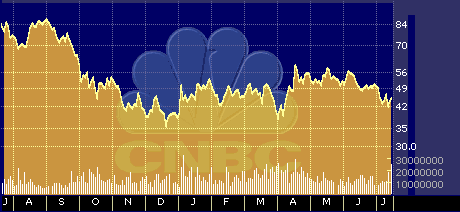
Best Is Ahead for Applied Materials
Best Is Ahead for Applied Materials
by Hal Plotkin
Silicon Valley Correspondent
Strong demand and a pending switch to new semiconductor-manufacturing technologies means the future looks bright for Applied Materials Inc. {AMAT}.
“I’ve been following the company since it went public, and this is about the best outlook we’ve ever had for them,” says Michael Murphy, publisher of the California Technology Stock Newsletter.
Applied Materials, based in Santa Clara, Calif., is the world’s leading maker of semiconductor-manufacturing equipment.

AMAT 52-week stock price chart
“They’re at the top of the electronic industry food chain,” says Mark FitzGerald, vice president of securities research and economics at Merrill Lynch in San Francisco. “Looking ahead, there’s very strong demand for their products,” he says.
According to a survey conducted by Semiconductor Equipment and Materials International, a trade group that represents about 80 percent of the industry, total revenue for semiconductor-manufacturing equipment makers in 1999 should be up about 9 percent from last year, hitting nearly $24 billion. Overall, the market is expected to grow an additional 18.3 percent next year, according to SEMI.
Several factors contribute to the strong demand that’s fueling growth at Applied Materials. First, there’s a sweeping set of new manufacturing technologies on the horizon that force chip makers to invest in new chip-making equipment. The new technologies and processes include the transition from 0.25 micron chips to even smaller 0.18 micron chips and the replacement of previously used interconnecting metals with higher-performance copper.
In addition, within the next few years semiconductor companies such as Intel {INTC} and Advanced Micro Devices Inc. {AMD} are expected to begin using 12-inch silicon wafers in their factories, called Fabs, in place of eight-inch wafers. The larger wafers increase the productivity of the chip-manufacturing process. They’re also sure to boost sales at Applied Materials. “When you move up to 12-inch wafers, you need to replace virtually every major piece of equipment,” Murphy says.
Semiconductor-manufacturing companies are making these investments because end-user demand is soaring. Strong sales of personal computers and other electronic devices that contain integrated circuits, such as cell phones, pagers, and personal digital assistants, has led to an urgent need for increased manufacturing capacity.
Applied Materials’ strong position in both U.S. and foreign markets should help the company capture a lion’s share of the growing global market. Now that Asian economies, in particular, are on the mend, analysts expect to see strong catch-up growth in that region.
In Taiwan, for example, where Applied Materials holds a dominant market share, a leading semiconductor manufacturer, Taiwan Semiconductor Manufacturing Co., recently announced it would boost spending on manufacturing equipment to $1.6 billion this year from $1.1 billion last year.
“Building up a strong presence in Asia is one of the smartest things [Applied Materials Chairman] Jim Morgan ever did,” FitzGerald says. “The company can really attribute its survival and success to Morgan.”
Another practice Morgan pioneered is his company’s almost religious obsession with customer service. Applied Materials routinely stations company personnel inside the factories of key customers, almost moving in with them. The approach gives company engineers early insights into customer needs and helps speed product-development cycles. “Applied Materials has the global infrastructure, depth of service, and support that is hard to duplicate,” FitzGerald says.
That status was enhanced by the 1998 acquisition of Mountain View, Calif.-based Consilium, a company that makes software used to run semiconductor-manufacturing equipment, including equipment sold by Applied Materials’ competitors such as KLA-Tencor {KLAC} and Novellus Systems {NVLS}, both based in San Jose, Calif. “The Consilium acquisition means Applied will be a super system integrator,” Murphy says. “You just know they’re going to be able to sell a whole lot of equipment.”
FitzGerald notes that the cyclical nature of the industry explains quarterly revenue increases that swing between five and 15 percent. “But if you figure, say, 10 percent average quarterly growth, that’s 40 percent annual growth,” he says. “For a company the size of Applied Materials, that’s terrific.”
Applied Materials reported earnings today of 61 cents a share for the fiscal third quarter ended Aug. 1, beating a consensus estimate of 53 cents, as provided by a First Call survey of 29 analysts. The company earned 19 cents in the year-earlier quarter.


